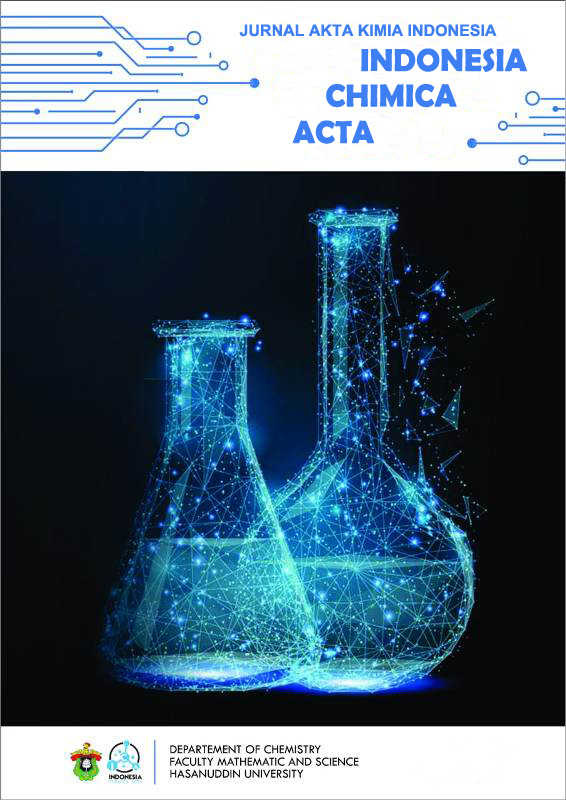α-Glucosidase Inhibitory Activity Of Cucurbitane Derivate Isolated From Methanol Extract Of Momordica charantia L. Leaves
DOI:
https://doi.org/10.20956/ica.v12i2.8341Keywords:
Cucubitane, Momordica charantia, momordicine I, α-glucosidaseAbstract
Cucurbitane derivative has been isolated from methanol extract of the leaves of bitter melon (Momordica charantia). Purification of methanol extract using vacuum column chromatography method using n-hexane: ethyl acetate as the mobile phase was obtained a white powder isolate. This isolate was elucidated to obtain chemical structures based on spectroscopic data (FT-NMR, FT-IR, and LC-MS/MS) and resulted a cucurbitane derivate, namely momordicine I. The MeOH extract and the isolate were evaluated for α-glucosidase inhibitory effect. Both MeOH extract and momordicine I showed moderate activities with %inhibition 27.34% and 15.79 % at 100 µg/mL repectively.
References
Grover JK, and Yadan SP. Medicinal plants of india with antidiabetic potensiaL, Journal of ethnopharmacology 2002; (81): 81-100.
Joseph B, and Jini D. Antidiabetic effects of Momordica charantia (bitter melon) and its medicinal potency. Asian Pac J Trop Dis 2013; 3(2): 93-102.
Kumar S, Sharathnath KV, Yogeswaran P, Harani, et al. A medical potency of Momordica charantia. Int. J. of Pharm Scie. Review and Research 2010; 1(2).
Svobodova B, Barros L, Calhelha CR, et al. Bioactive Properties And Phenolic Profile Of Momordica Charantia L. Medicinal Plant Growing Wild In Trinidad And Tobago, Industrial Crops and Properties 2016; xx, xxx-xxx.
Zhanga J, Yan H,Takashi K, et al. Cucurbitane Triterpenoids from the Leaves of Momordica charantia and Their Cancer Chemopreventive Effects and Cytotoxicities Chemistry & Biodiversity 2012; Vol. 9.
Tan MJ, Ye JM, Turner N, Hohnen-Behrens C, Ke CQ, Tang CP. Antidiabetic Activities Of Triterpenoids Isolated From Bitter Melon Associated With Activation Of The AMPK Pathway, Chem Biol 2008; 15: 263-269.
Nguyen XN, Phan VK, Chau VM, et al. a -Glucosidase Inhibition Properties of Cucurbitane-Type Triterpene Glycosides from the Fruits of Momordica charantia, Chem. Pham. Bull 2010; 58(5): 720-724).
Kulkarni P, Lohidasan S, & Mahadik K. Isolation, characterisation and investigation of in vitro antidiabetic and antioxidant activity of phytocontituents from fruit of momordica charantia Linn. Natural Products Research 2019; 1-3.
Ben GA, Ben AK, Jardak N, et al. Inhibitory Activities of Cystoseira Crinita Sulfated Polysaccharide on Key Enzymes Related to Diabetes and Hypertension: In Vitro and Animal Study, Arch. Physiolog Biochem 2017; 123(1): 31–42.
Jenkins DJ, Taylor RH, Goff DV, et al. Scope And Specificity Of Acarbose In Slowing Carbohydrate Absorption In Man, Diabetes 1981; 30: 951—954.
Fajriah S, Akhmad D, Megawati, & Hanafi M. Isolation and Identification of Quercetin Derivatives and their α-Glucosidase Inhibitory Activities from Bryophyllum pinnatum. Research J. of Chem and Environment 2018; 22(11): 114-119.
Yasuda M, Iwamoto M, Okabe H, and Yamauchi T. Structure of Momordicine I, II, III, The Bitter Princple in The Leaves and Vines of Momordica charantia L, Chem. Pharm Bull 1984; 32(5): 2044-2047.
Zhang YB, Liu H, Zhu CY, Zhang MX, et al. Cucurbitane-Type Triterpenoids From The Leaves Of Momordica Charantia, Journal of Asian Natural Products Research 2014; 16(4); 358-363.
Downloads
Published
Issue
Section
License
This is an open access journal which means that all contents is freely available without charge to the user or his/her institution. Users are allowed to read, download, copy, distribute, print, search, or link to the full texts of the articles in this journal without asking prior permission from the publisher or the author.
Jurnal Akta Kimia Indonesia (Indonesia Chimica Acta) operates a CC BY-SA 4.0 © license for journal papers. Copyright remains with the author, but Jurnal Akta Kimia Indonesia (Indonesia Chimica Acta) is licensed to publish the paper, and the author agrees to make the article available with the CC BY-SA 4.0 license. Reproduction as another journal article in whole or in part would be plagiarism. Jurnal Akta Kimia Indonesia (Indonesia Chimica Acta) reserves all rights except those granted in this copyright notice.



